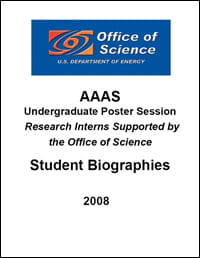Undergraduate Research Interns Sponsored by the U.S. Department of Energy's Office of Science Presenting Research at 2008 AAAS Annual Meeting Poster Session
February 14, 2008
The American Association for the Advancement of Science (AAAS) has invited 22 undergraduate interns sponsored by the U.S. Department of Energy’s Office of Science to present their research in the Poster Session at this year’s AAAS annual meeting in Boston, Massachusetts on February 14-18.
Each year, the Office of Science’s Office of Workforce Development for Teachers and Scientists (WDTS) provides funding for more than 600 undergraduate students to participate in hands-on mentored research internships at one of the 17 DOE National Laboratories. At the final stages of their time at a laboratory, students are asked to write a research paper to document their work. Each year, the top student intern papers are selected on a peer-reviewed basis to be published in the Office of Science’s annual Journal of Undergraduate Research.
The AAAS is the world’s largest general scientific society, and publisher of the prestigious journal, Science. As part of its annual meeting, AAAS hosts an undergraduate Poster Session, which provides a forum for selected individuals to present their research. Since 2003, AAAS has partnered with the Office of Science to recognize the accomplishment of outstanding undergraduates by inviting DOE interns whose papers are to be published in that year’s Journal of Undergraduate Research to present their research papers at the AAAS annual meeting.
Information on the 22 DOE Office of Science undergraduate interns who were invited to present their research at this year’s AAAS annual meeting poster session is available in this booklet:The 22 students did their internships at 10 of the DOE National Laboratories (Argonne National Laboratory, Brookhaven National Laboratory, Fermi National Accelerator Laboratory, Thomas Jefferson National Accelerator Facility, Lawrence Berkeley National Laboratory, National Renewable Energy Laboratory, Oak Ridge National Laboratory, Pacific Northwest National Laboratory, Princeton Plasma Physics Laboratory and Stanford Linear Accelerator Center.)
Each of the 11 men and 11 women participated in one of the four Workforce Development for Teachers and Scientists programs for undergraduates:
- The Student Undergraduate Laboratory Internship (SULI) program is for university and community college students considering a career in science and/or engineering.
- Students from community colleges also may participate in the Community College Institute (CCI) Program, which offers research internships in Science, Engineering and Technology, as well as career planning and training.
- The Pre-Service Teacher Program (PST) is for undergraduate students who are preparing to become K-12 science, technology or math teachers. This is a program where future teachers are paired with a master teacher and a laboratory scientist.
- The Faculty and Student Teams (FaST) Program pairs two or three undergraduate students and a faculty member from colleges and universities that receive below the 50th percentile in federal research funding, as well as minority serving institutions, to form a team that conducts cutting edge research as they partner with the laboratories.
WDTS programs encourage students to participate in a variety of experiential programs outside of the classroom. More information on WDTS programs and online copies of the Journal of Undergraduate Research are available at: http://www.scied.science.doe.gov.
The Department of Energy’s Office of Science is the single largest supporter of basic research in the physical sciences in the nation and helps ensure U.S. world leadership across a broad range of scientific disciplines. The Office of Science supports a diverse portfolio of research at more than 300 colleges and universities nationwide, manages 10 world-class national laboratories with unmatched capabilities for solving complex interdisciplinary scientific problems, and builds and operates the world’s finest suite of scientific facilities and instruments used annually by more than 19,000 researchers to extend the frontiers of all areas of science. More information on the Office of Science is available at: http://www.science.doe.gov/.


